Chabówka 2023-07-19
Passenger cars "Boczniak".
The "Boczniak" type passenger cars owe their name to the numerous side entrances to the interior and the possibility of walking along the outer platforms along the car. The "Boczniak" wagons are basically the first group of typical railway passenger cars. Their design derives from passenger and postal vehicles, widely used in intercity transport in the first half of the 19th century. The first railway wagons of this type were open structures, without windows, as in horse-drawn carriages.
Then, the pattern used in Mail Coach sled vehicles was adopted. This vehicle had a passenger part (compartment) and a mail and luggage part. The next level was to combine several such passenger parts into one car. The railroad drew most from the construction of carriages of the traveling type; stagecoach and dormeza. A stagecoach was a large closed horse-drawn vehicle designed to transport people and small goods according to a fixed timetable. The classic stagecoach was pulled by 4 or 6 horses, which were changed every 30-35 km. The stagecoach was used in Europe from the 16th century to the end of the 19th century. Dormeza from French dormeuse - a couch, a couch, it was a covered carriage, a kind of carriage, which was used for further journeys and was also adapted to sleep while driving.
Since the possibilities of the railway were definitely greater than the possibilities of horse-drawn vehicles, the wagons were enlarged so that they could accommodate up to 50 people. And here the development paths of passenger cars and horse-drawn vehicles diverged. The railway was developing, and sled vehicles were going down in history.
Initially, the production of railway carriages was carried out by companies producing coaches and carriages, which over time switched to the production of carriages only. Companies that produced freight wagons had a better position on the market, because having wheelsets and underframes at their disposal, they could build passenger wagon bodies on them.
Wagons with side entrances were characteristic of PKP, both after 1918 and after 1945. We took over a lot of "Boczniak" wagons of Prussian production, from German regional railways, as well as Belgian, French and Italian vehicles. In the period 1918-1922, Polish Railways took over many "Boczniak" wagons. Mostly Prussian production. In 1945, they received the type designation Cy, and after 1956, the designation was changed to By. After the end of World War II, the Polish State Railways had about 6,500 passenger cars. However, the number of active wagons was smaller and amounted to only 3,500 wagons. These were mainly two-axle and three-axle passenger cars. Many of these wagons were of wooden construction. The capacity of these wagons was small compared to the needs. Therefore, covered freight wagons, temporarily adapted for passenger transport, as Class 4, were often attached to passenger trains. "Boczniak" wagons were used until the end of the 1960s. Even in the 70s you could meet them on railway sidings. Occasionally they were attached to trains that were overcrowded. This was a partial solution, because these wagons usually had a maximum speed of only 60 km/h.
The "Boczniaki" wagons were the first widely used type of wagon intended for passenger transport. There were several compartments in the carriage, each with a separate entrance on both sides, just like in a carriage. In addition, there was a step along the entire carriage, which allowed the conductor to move from compartment to compartment while the train was moving (running). This step was used by travelers who were looking for more comfortable and less crowded compartments. Although in theory it was forbidden.
The car's structure was wooden and covered with sheet metal from the outside. The car body was mounted to a metal underframe. The interior is lined with boards. Skylights were placed in the roof of the wagon. Practice has shown that wagons with mixed construction: wood and metal, are safer in the event of a railway accident than wooden structures. They are more difficult to ignite, and their construction is much stronger. Their lifespan has also been extended.
Passenger car BCy 023 240.
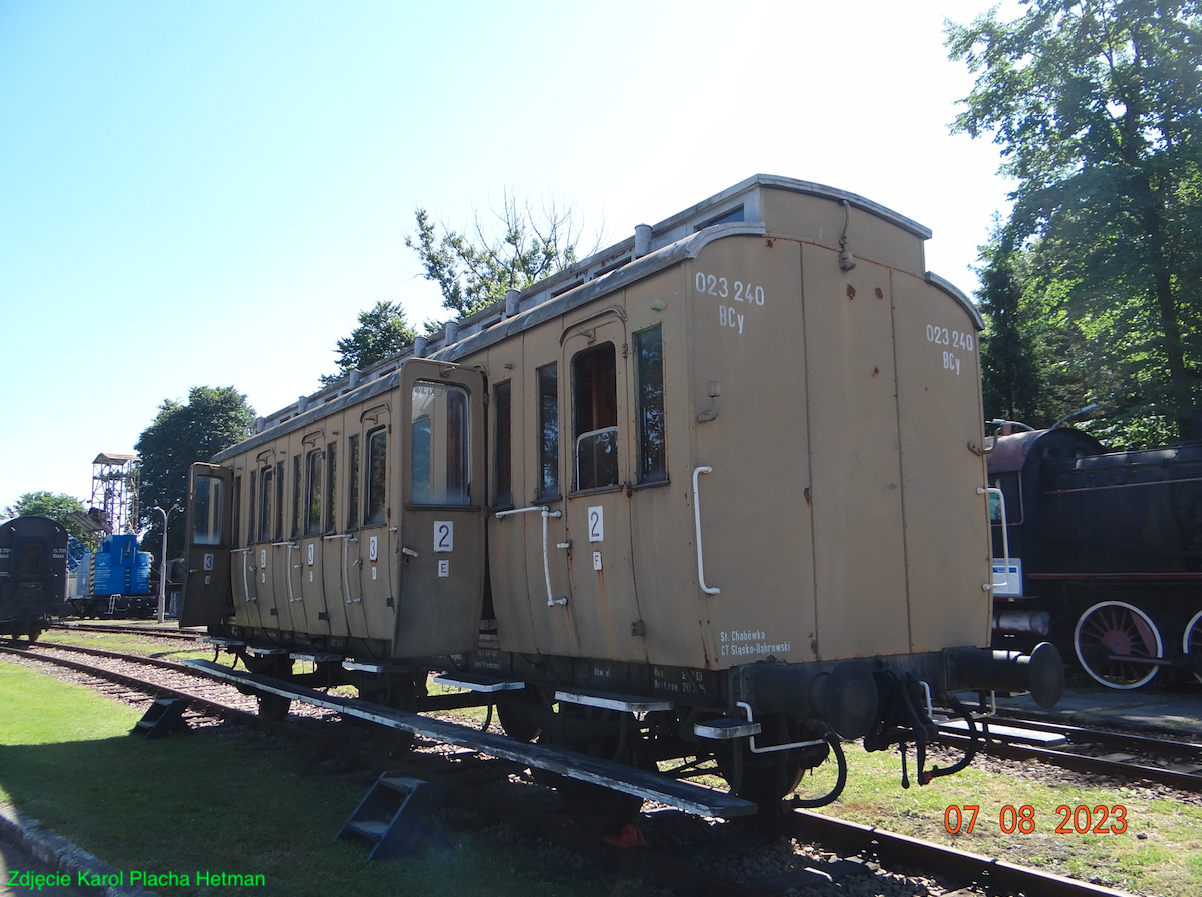
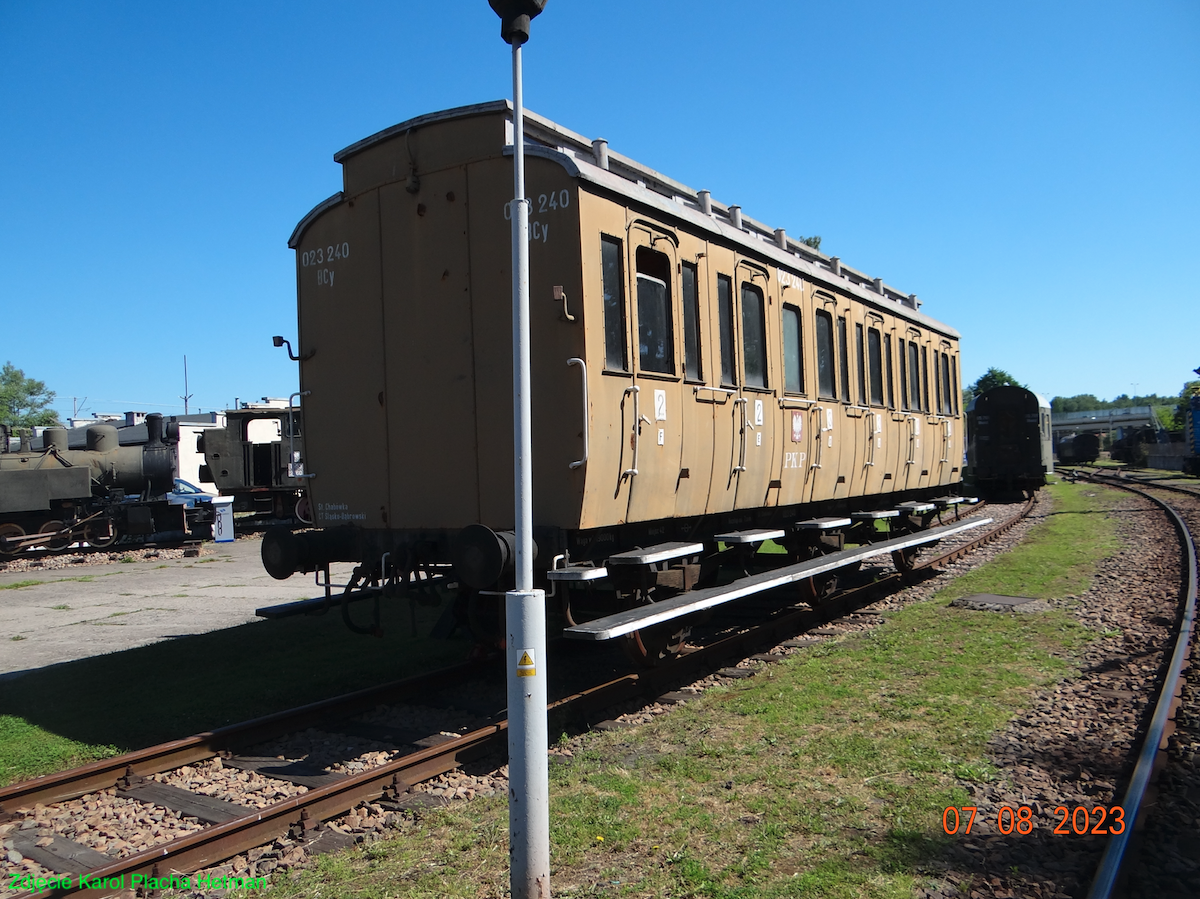
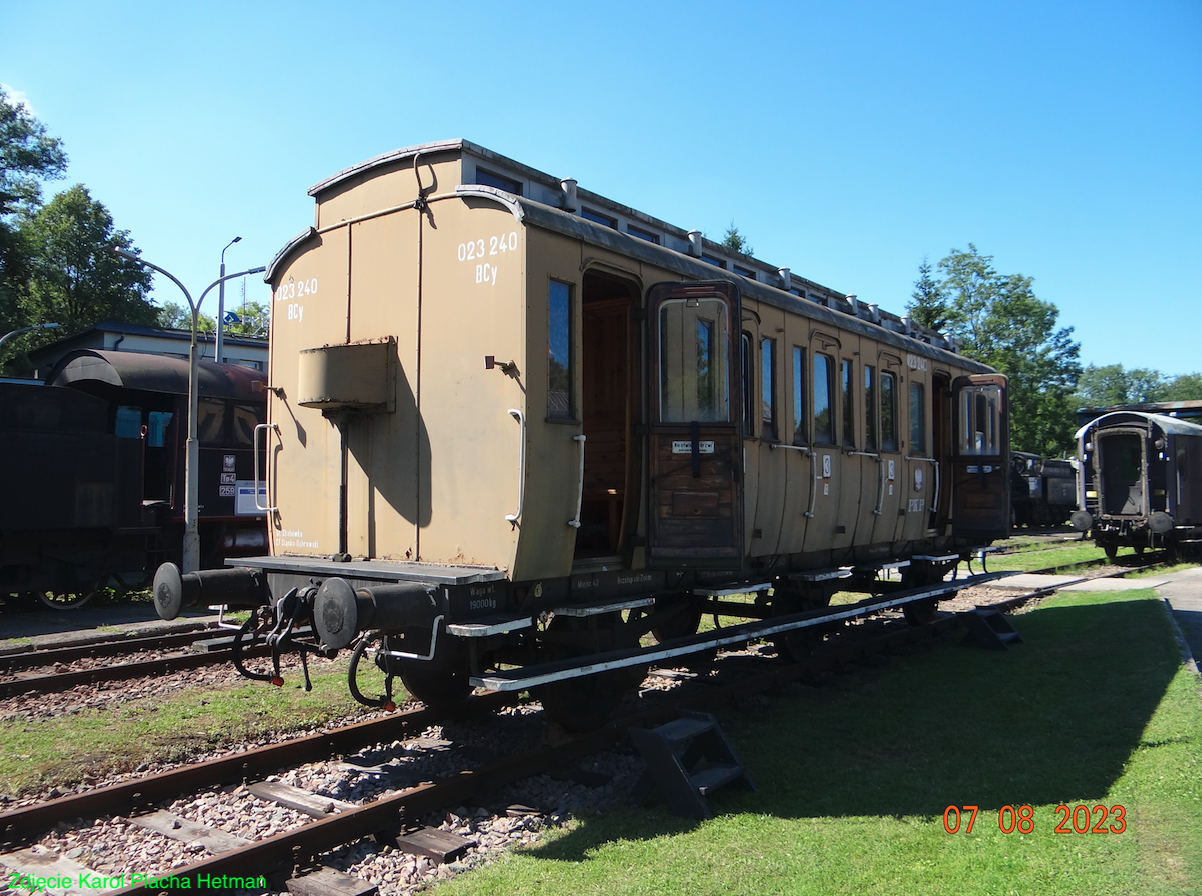
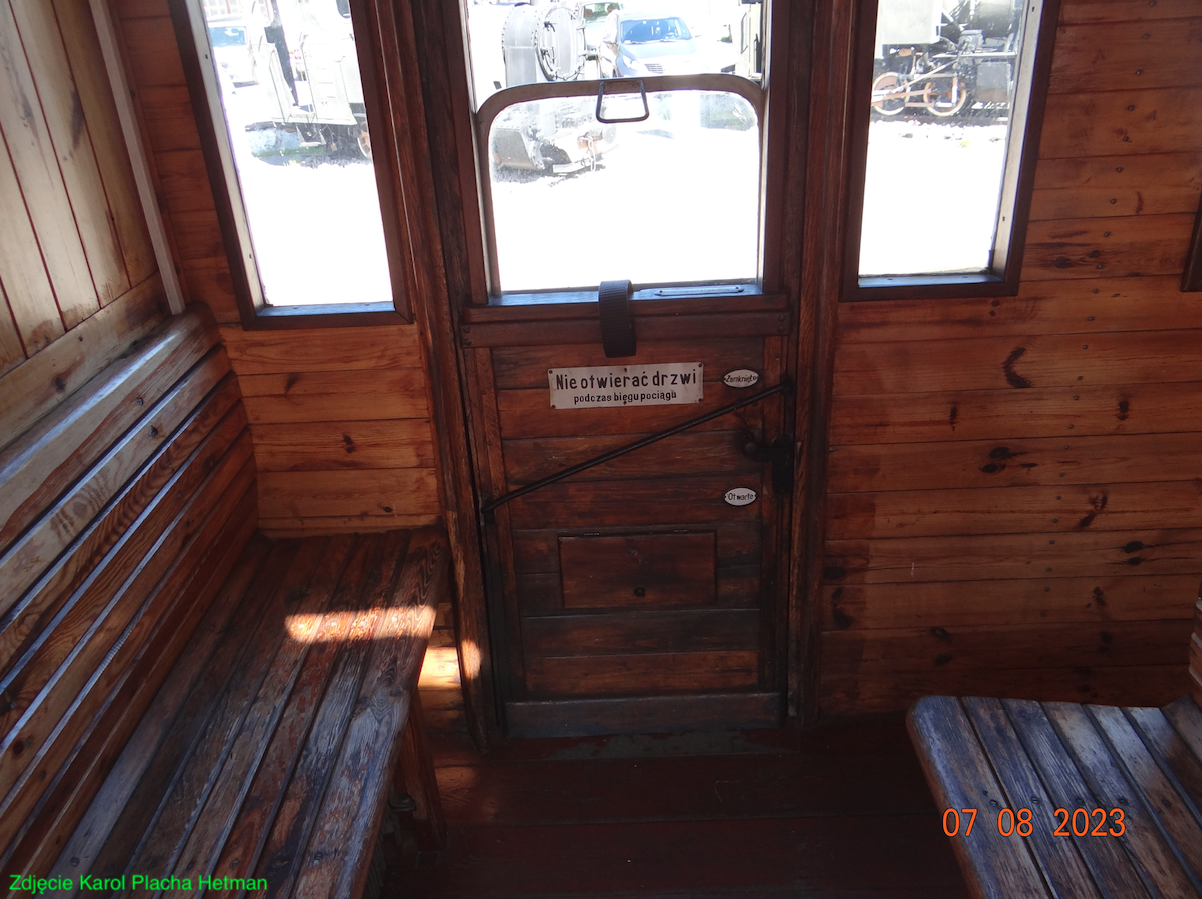
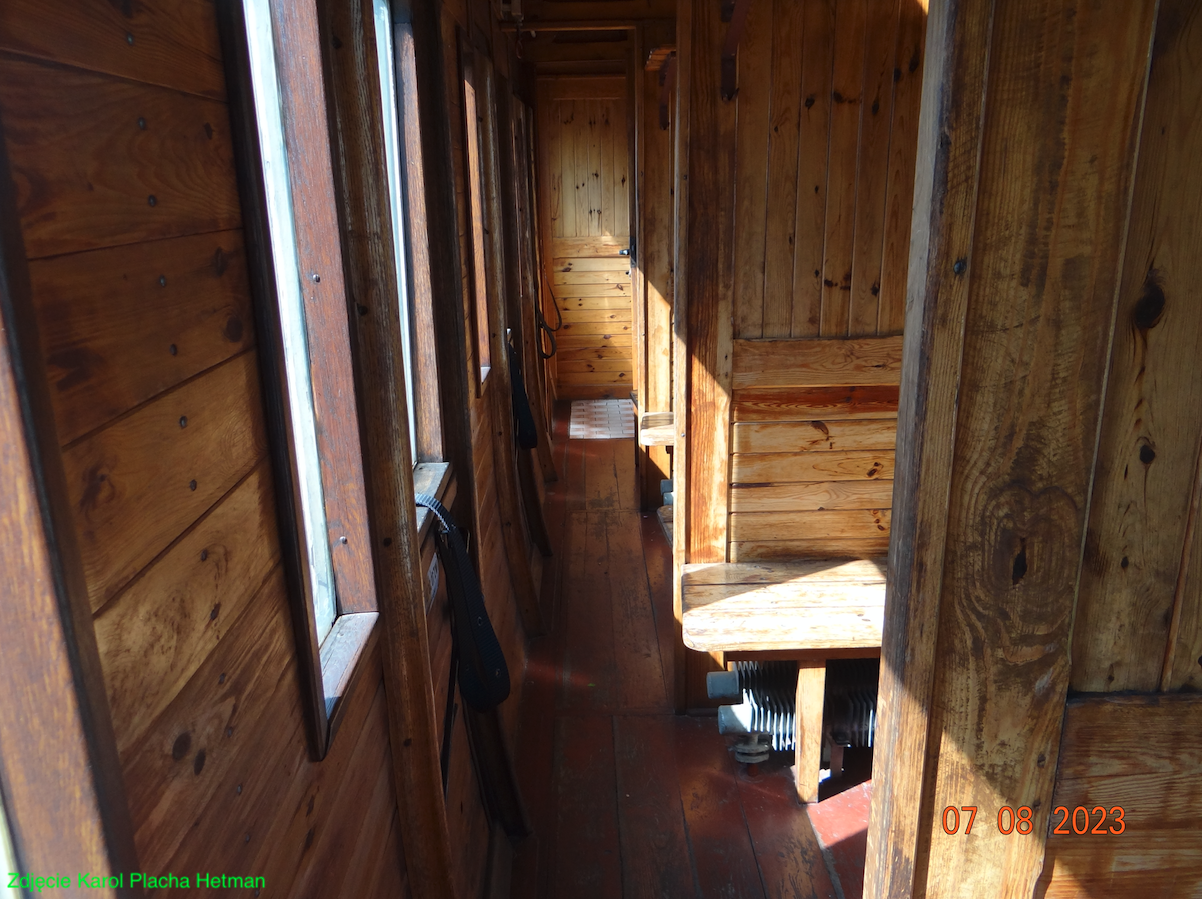
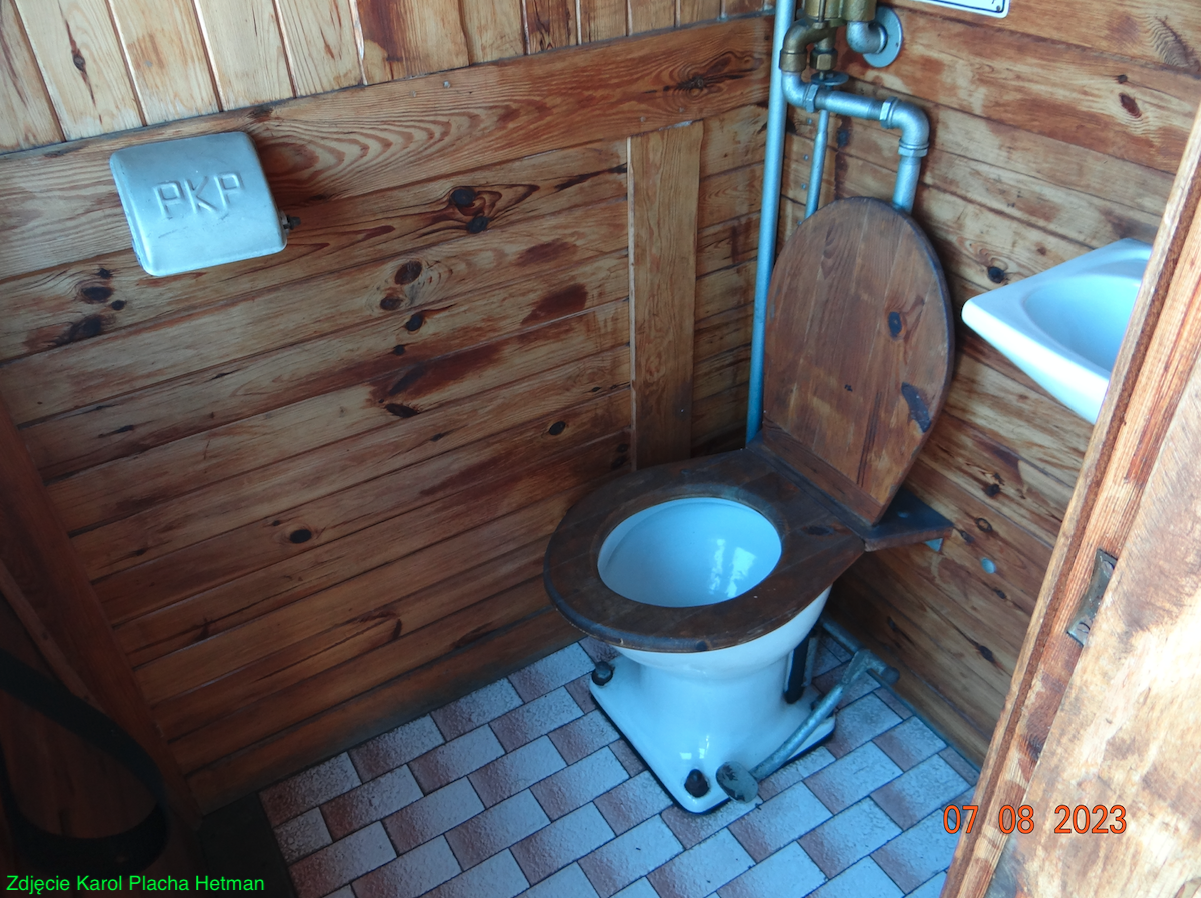
The BCy 023 240 passenger car is one of the oldest passenger cars in the collection of the Railway Open Air Museum in Chabówka. The wagon belongs to the "Boczniak" type wagons, it was built in 1906. The manufacturer of this wagon is unknown. After the defeat of the World War by the Germans, in 1918, many wagons of this type were taken over by the newly established company Polskie Koleje Państwowe in Wielkopolska. When the Germans realized that the rebirth of the Republic of Poland had become a fact, they sent their best locomotives and wagons to the west. However, they were forced by the Western countries to give Poland a certain number of locomotives and wagons. That is why they donated the oldest and most used equipment. Let us remember that the Germans generally considered Poland to be a seasonal country, and that is why, after 20 years, another world war took place.
The situation repeated itself in 1945, when after the Second World War, started by the Germans and the Soviets, the Germans lost a significant part of the rolling stock. The only difference is that the best locomotives and wagons were taken by the Soviets from Pomerania and Silesia to the East. Most inhabitants of Silesia and Pomerania left for the west, fleeing from the Soviet soldiers. But some stayed. There were acts of vandalism on the rolling stock, which was taken over by PKP. Throwing stones at moving PKP trains was not uncommon.
In the 1920s, "Boczniak" wagons were directed mainly to secondary routes, which were less loaded with passengers. Freight wagons, both covered and uncovered, were often included in the trains.
Construction description BCy 023 240.
The car is a three-axle car designed to carry passengers in Class 2 and Class 3. The underframe of the car is made of steel, and the body is made of wood and covered with sheet metal. Mainly pine wood was used, which is relatively cheap and durable, provided that it is well protected against moisture. Along the roof of the car there is a platform with skylights and mechanical ventilation shutters that can be closed or opened.
There are 12 doors to the wagon, 6 on each side. The doors are equipped with opening windows that can be locked in the closed or open position with a webbing strap.
From the outside of the car, there are wooden platforms that can be walked on while the train is moving. In addition, there are handrails to maintain balance. The piers were intended for train service, not for passengers.
The wagon was equipped with six compartments; two 2nd Class compartments and four 3rd Class compartments. In both classrooms the benches are wooden, so-called hard benches. The difference is that in Class 2 the benches are profiled. Each compartment is accessed by doors on both sides of the car. The car is inaccessible, but the 3rd Class compartments are connected by a side corridor. The compartments of 2nd Class are similarly connected. Each of these corridors leads to a toilet, separate for 2nd Class and 3rd Class. The toilets are located closer to the center of the car and share a common water tank. Each toilet has a faience toilet bowl with a wooden toilet seat. There is a faience sink in each toilet. Galvanized metal sinks were commonly used. The toilet is of the open type and all waste falls onto the track. The toilets have frosted glass windows and electric lighting. The last renovation of the toilets was done in the 80s of the twentieth century, as evidenced by the ceramic tiles on the floor (15 cm x 7.5 cm) typical of the 80s.
The entire interior of the wagon is made of wood and painted with colorless varnish. The floor is wooden and painted with brown oil paint. Most boards and slats are fixed with screws. Luggage racks are also made of planks and are supported by metal hangers.
The wagons were gradually modernized. In the 40s, the wagons were equipped with an electrical installation used to illuminate the interior. In the 1950s, many carriages were adapted for steam heating. Radiators with fins were installed under the benches.
Three-axle wagon.
The wheelsets are based on leaf springs. Plain bearings were used. The use of three axles in passenger cars had its justification. The introduction of the third axle was intended to increase the stability of the wagon and improve the comfort of passengers. Thanks to the increased number of axles, the wagon could cope better with uneven tracks and provide a more stable ride. Especially when driving over railroad connections. This translated into less shocks and vibrations that could affect the comfort of travelers. The three axles also contributed to the improvement of passenger safety. More axles and wheels increased stability and the ability to maintain balance during hard braking or cornering. This reduced the risk of derailment and improved overall travel safety. However, there is no doubt that the arrangement of a passenger car with two two-axle bogies is definitely better.
T-T data of the BCy 023 240 wagon:
Built in 1906. Length 13.00 m. Width 2.85 m. Curb weight 18,000 kg. Maximum speed 60 km/h. Electric lighting. Steam heating. Pneumatic service brake. Manual parking brake, activated from inside the car. Number of seats 55-66.
Modernization of "Boczniak" wagons.
A big change in improving the comfort of travel was the installation of a toilet in the car. At that time, corridors had to be introduced in the carriages so that each traveler could use the toilet. The introduction of the corridor in wagons resulted in the gradual elimination of "Boczniaków" wagons, which were not produced in Poland.
In PKP already in the 20s of the twentieth century, numerous modifications were made to the wagons. Executed transitions between compartments. One of the toilets was removed, so you could walk the entire length of the car. Wooden but profiled benches were installed.
Almost all "Boczniak" wagons had a booth at one end, which housed the handbrake crank. The booth protruded above the roof of the car. These booths were liquidated relatively quickly. At that time, the hand brake crank was placed in a compartment on one of the gable walls, which was covered with sheet metal from the outside.
Very quickly the wagons were illuminated inside. Initially with kerosene, carbide or gas lamps. Then came electric lighting with dim light bulbs. In Poland, electrical installations have been installed since the early 1950s.
In Poland, the first "Boczniak" wagons received central steam heating in 1958. The installation was powered by steam from a steam locomotive. In the winter, heating wagons were used so as not to take energy from the locomotive.
Production of passenger cars in Poland in Poznań.
In 1928, the production of passenger cars was launched in Poznań, and in 1930, the hundredth copy left the factory. In 1928, 5 Gmx passenger cars were built. In the period 1928-1930, 10 dining cars were built for Paris, on special order. In the period 1928-1939, 70 passenger cars of the Chxz type were built, and in the period 1930-1938, 130 cars of the Chrz type were built. In 1934 and 1939, 35 Churz wagons were built. All these wagons were modern constructions, based on two two-axle bogies.
During World War II, the plant in Poznań was occupied by the German arms concern Deutsche Waffen und Munitionsfabriken, and was called DWM Posen and produced rolling stock for the needs of the Germans. On January 22, 1945, the Germans left the factory, taking machine tools and other equipment to the west. On January 28, 1945, the factory in Poznań was occupied by the Soviet administration during the war. On February 8, 1945, the Cegielski Plant was handed over to the Provisional State Administration, i.e. the communists.
In 1946, Zakłady Przemysłu Metalowego H. Cegielski Poznań was established, and the rolling stock factory operating within them was named Fabryka Wagonów. By 1950, over 500 wagons were built there for PKP, and in the period 1950-1960, 2,846 wagons of various types were produced for CCCP. It was only from the 1960s that the vast majority of production was sent to PKP service.
Written by Karol Placha Hetman
